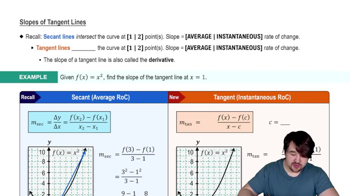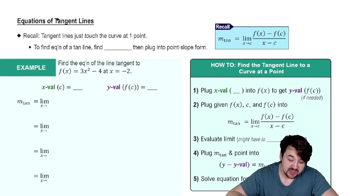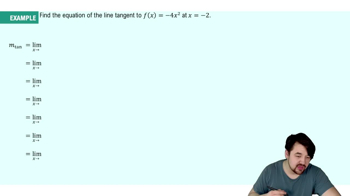Table of contents
- 0. Functions7h 52m
- Introduction to Functions16m
- Piecewise Functions10m
- Properties of Functions9m
- Common Functions1h 8m
- Transformations5m
- Combining Functions27m
- Exponent rules32m
- Exponential Functions28m
- Logarithmic Functions24m
- Properties of Logarithms34m
- Exponential & Logarithmic Equations35m
- Introduction to Trigonometric Functions38m
- Graphs of Trigonometric Functions44m
- Trigonometric Identities47m
- Inverse Trigonometric Functions48m
- 1. Limits and Continuity2h 2m
- 2. Intro to Derivatives1h 33m
- 3. Techniques of Differentiation3h 18m
- 4. Applications of Derivatives2h 38m
- 5. Graphical Applications of Derivatives6h 2m
- 6. Derivatives of Inverse, Exponential, & Logarithmic Functions2h 37m
- 7. Antiderivatives & Indefinite Integrals1h 26m
- 8. Definite Integrals4h 44m
- 9. Graphical Applications of Integrals2h 27m
- 10. Physics Applications of Integrals 2h 22m
2. Intro to Derivatives
Tangent Lines and Derivatives
Problem 3.5.72a
Textbook Question
Find an equation of the line tangent to the following curves at the given value of x.
y = 4 sin x cos x; x = π/3
 Verified step by step guidance
Verified step by step guidance1
First, understand that the problem requires finding the equation of the tangent line to the curve y = 4 sin x cos x at x = π/3. The tangent line will have the form y = mx + b, where m is the slope at the given point and b is the y-intercept.
To find the slope of the tangent line, we need to compute the derivative of the function y = 4 sin x cos x with respect to x. Use the product rule for differentiation, which states that if you have a function u(x)v(x), its derivative is u'(x)v(x) + u(x)v'(x).
Apply the product rule: Let u(x) = 4 sin x and v(x) = cos x. Then, u'(x) = 4 cos x and v'(x) = -sin x. The derivative of y with respect to x, denoted as dy/dx, is: dy/dx = u'(x)v(x) + u(x)v'(x) = 4 cos x * cos x + 4 sin x * (-sin x).
Simplify the expression for dy/dx: dy/dx = 4 cos^2 x - 4 sin^2 x. This can be further simplified using the trigonometric identity cos(2x) = cos^2 x - sin^2 x, giving dy/dx = 4 cos(2x).
Evaluate the derivative at x = π/3 to find the slope m of the tangent line: m = 4 cos(2 * π/3). Calculate the value of y at x = π/3 using the original function y = 4 sin x cos x, and use these values to find the equation of the tangent line in the form y = mx + b.
 Verified video answer for a similar problem:
Verified video answer for a similar problem:This video solution was recommended by our tutors as helpful for the problem above
Video duration:
7mPlay a video:
Was this helpful?
Key Concepts
Here are the essential concepts you must grasp in order to answer the question correctly.
Tangent Line
A tangent line to a curve at a given point is a straight line that touches the curve at that point without crossing it. The slope of the tangent line is equal to the derivative of the function at that point. This concept is crucial for finding the equation of the tangent line, as it provides both the slope and the point of tangency.
Recommended video:

Slopes of Tangent Lines
Derivative
The derivative of a function measures how the function's output changes as its input changes. It is defined as the limit of the average rate of change of the function as the interval approaches zero. In this context, calculating the derivative of the function y = 4 sin x cos x will allow us to find the slope of the tangent line at x = π/3.
Recommended video:

Derivatives
Trigonometric Identities
Trigonometric identities are equations that involve trigonometric functions and are true for all values of the variables involved. In this problem, the identity sin(2x) = 2 sin x cos x can simplify the function y = 4 sin x cos x to y = 2 sin(2x), making it easier to differentiate and evaluate at specific points.
Recommended video:

Verifying Trig Equations as Identities

 5:13m
5:13mWatch next
Master Slopes of Tangent Lines with a bite sized video explanation from Nick
Start learningRelated Videos
Related Practice



